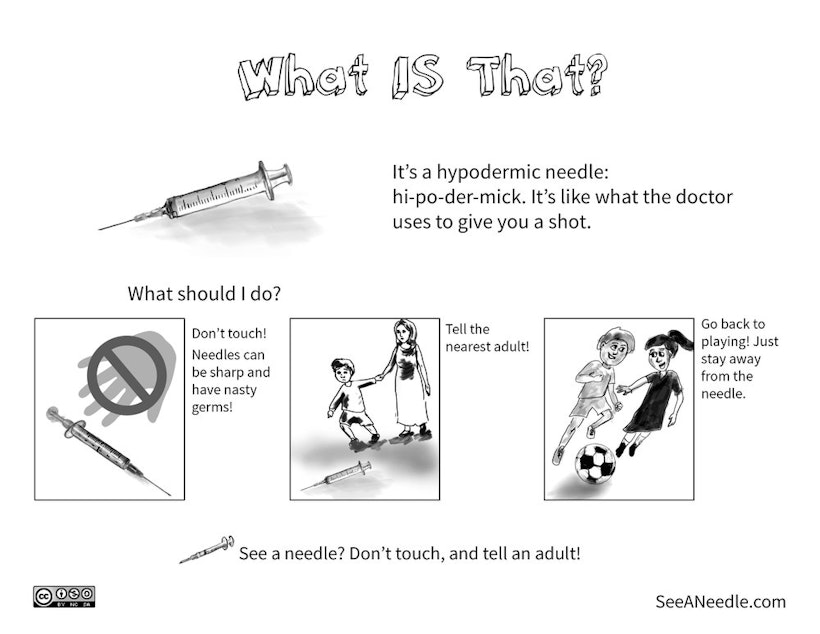I found a used needle in Seattle. What should I do?

Don't freak out. Here are some tips.
KUOW listener Mark Reutter recently found a discarded hypodermic needle in the University District.
It was after dinner and Reutter and his girlfriend were walking back to their car when they spotted a single needle attached to a white plastic syringe in the middle of the sidewalk.
“It was sitting there, right in the open,” he said.
The couple didn’t want anyone to step on it, but they didn’t have anything to pick it up with either.
Instead, Reutter kicked it a few feet over so it landed at the base of a parking sign—just so it was out of the way.
Sponsored
Then, he asked KUOW, “What should you do when you come across a needle?”
We found the answer.
If you find a needle on public property in Seattle:
Report it to the city using the Find it, Fix it smartphone app (Google Play or iPhone) if you find the discarded needle on public property, Seattle Public Utilities manager, Idris Beauregard said.
You can upload a picture of the location of the needle to help city workers find it. You can also call the city’s hotline at 206-684-7587.
Sponsored
Someone will respond within 24 hours and properly dispose of the needle, Beauregard said.
“When you put in that request it automatically notifies one of our needle inspectors,” Beauregard said. “They’ll go out to the location, they’ll inspect the area, secure the area and then collect the needles.”
Gather the right equipment, he said, if you want to dispose of it yourself.
- Gloves, to prevent the spread of germs
- Tongs (like salad tongs) or some kind of trash grabber
- A thick plastic container with a tight-fitting lid, such as a sharps container sold at a pharmacy (smaller ones cost around $6), soda bottle, or Tupperware (something under two liters will fit in a disposal container)
The city recommends:
Sponsored
- Place the container on the ground.
- Grab the needle by the plastic—not the pointy—end.
- Don’t recap it.
- Place the needle in the container, sharp end down, and close the lid.
- Label the container “SHARPS, DO NOT RECYCLE”
City law prohibits disposing of hypodermic needles in the garbage to protect waste workers from getting pricked.
Instead, take the container with the needle to one of the nine sharps boxes throughout the city, or a waste transfer station.
If you find a needle on private property in Seattle:
Seattle city workers can only respond to Find it, Fix it app requests on public property, Beauregard said.
Sponsored
You can file a complaint through the Seattle Department of Construction and Inspections if there is a code violation, or you can use the steps above to pick up the needle and dispose of it properly.
If you find a needle outside Seattle:
In King County, you can take needles in sturdy, leak-proof containers to the waste transfer stations in Factoria, Bow Lake, Shoreline and Vashon Island and drop them off in a designated kiosk.
The King County Department of Public Health also has sharps boxes available 24-hours a day at health centers in Auburn, Downtown Seattle, Bellevue, and Federal Way.
You can also search for local options at SafeNeedleDisposal.org.
Sponsored
King County Solid Waste echoes the advice for picking up a loose needle: Don’t use your bare hands. Instead, use gloves and tongs or even a boom and dust bin, and put it in a rigid container you can seal.
You can legally throw out a needle in a pop bottle in your garbage in King County, but it’s the “least preferred option,” Solid Waste Division spokesman, Matt Manguso said.
Needles are scary, but the risks are low
It’s hard to find good numbers on how many people have gotten stuck over the years. That data is not tracked by the Centers for Disease Control and Prevention, the Seattle and King County public health department, or the Washington State Department of Health, according to spokespeople from each place.
However, researchers have gathered data when people with needle stick injuries report to an emergency department, and their studies show the injuries very rarely lead to disease.
For example, one study of patients in Montreal hospitals found none of the 274 children injured by a needle between 1988 and 2006 had gotten an infection such as Hepatitis B, Hepatitis C, or HIV.
In another report, researchers reviewed 16 studies covering 1,565 needle-stick injuries from 1987 and 2011 and found one Hepatitis B transmission to an unvaccinated adult caring for a relative with a Hepatitis B infection.
“The risk of infection is extremely small,” said Dr. Hank Bernstein with the American Academy of Pediatrics. “But I have to say that the anxiety level that's raised in parents is extremely high.”
HIV and Hepatitis C won’t survive longer than 24 hours out in the open, he said.
“Unfortunately with Hepatitis B, just a very small amount can actually last in the environment for up to a week.”
In case you or someone you know is stuck:
Bernstein recommends adults wash out the wound with soap and water and call the child’s doctor.
The adult and the pediatrician should talk about the wound and the child’s immunization history — have they been vaccinated against Hepatitis B and Tetanus? How deep is the wound?
“It's appropriate to be concerned, and it warrants prompt attention,” Bernstein said. “It's not something that someone should ignore or wait till tomorrow.”
By the way, he said that after you talk with a doctor, you can dispose of the needle safely. You don’t need to bring it with you to the clinic or hospital to test for viruses, he said, because the results will likely be negative.




